
CURATOR’s EYE
3 minutes Art -IKU→-
Follow TRiCERA on Instagram and check out our creative artists
5%OFF & free shipping 1st purchase
FIRSTART5
10%OFF 2nd purchase after 1st purchase!
Welcome to TRiCERA
Hi there! We are pleased to have you here 🎉
Could you please describe yourself?
Guest
Pop and cute stick figures (?) in various poses. Stick figures in various poses.
The art created by Keith Haring (1958 - 1990) is loved around the world.
In this issue, we will introduce the life and works of Keith Haring, who is known as a pioneer of street art in the United States.
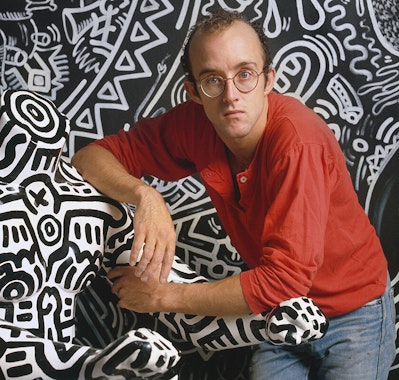
Keith Haring is a representative of the graffiti culture that swept New York City in the 1980s, known for his instantly recognizable drawings of people and dogs with a simple touch.
His career began with graffiti on the New York subway, which quickly became popular with the public, and he went on to create murals and other works in public spaces that are often referred to as public art.
In Japan, the Nakamura Keith Haring Museum of Art was established in 2007 in Yatsugatake, Yamanashi Prefecture, and continues to play a role in introducing Haring to Japanese art fans with its contemporary architecture and colorful, fun museum store.
His sexuality is an important feature of Haring's work.
Many of his works also allude to his sexuality. He has continued to look at the nature of his own homosexual orientation in his work, and he is also highly regarded as an activist who has been openly advocating for sexual minorities since the early days when gender activism was not a common practice.
Haring was born in Pennsylvania into a devout Christian family.
He was interested in drawing from an early age and painted with his father.
It is also said that she often watched cartoons such as Walt Disney's animated cartoons, Dr. Seuss, Charles Schulz, and The Bugs Bunny Show, which are thought to have been the basis for her later pop style.
After high school, he studied at the Ivy School of Professional Art in Pittsburgh, but became bored with the coursework and began to search for his own unique pursuits.
He was so struck by Robert Henri's "The Spirit of Art" (1923) that he began to create what he wanted to create, as if absorbed in the process.
Around 1978, when he was around 20 years old, Haring was working at the Pittsburgh Center for the Arts, where he was greatly influenced by the great artists whose works he saw up close.
He was struck by the power of works by Pierre Alessinsky, Jean Dubuffet, Jackson Pollock, Mark Tobey, and others. He also heard a lecture by Christo, a native of France who worked on various large-scale projects as Christo & Jeanne-Claude, a husband and wife team, which shaped his fundamental ideas about the value of art in the public sphere.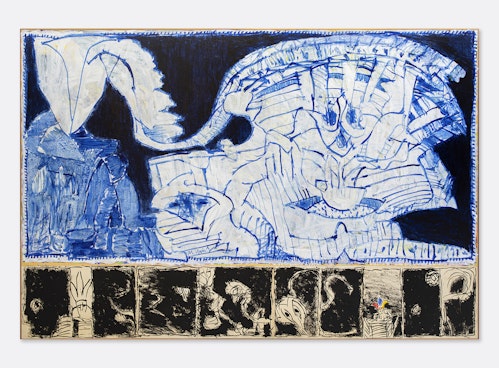
Pierre Alesinski, "Dotremont dans sa nuit lapone
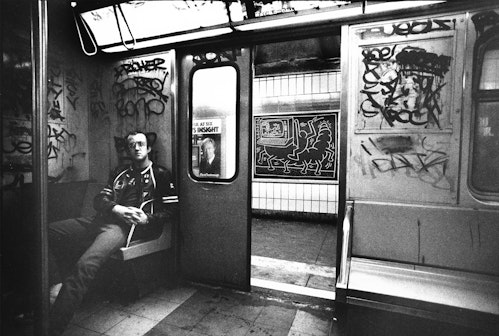
Around the same time, Haring began studying painting at the School of Visual Arts (SVA) in New York City.
He also worked part-time in nightclubs and explored new forms of expression such as video and performance art.
While still in school, he created graffiti art on the Manhattan subway, which attracted a lot of attention.
Haring first began painting with white chalk on the backs of unused advertising boards. The "Radiant Baby" series, a motif that has come to symbolize Haring, was being painted as early as this time.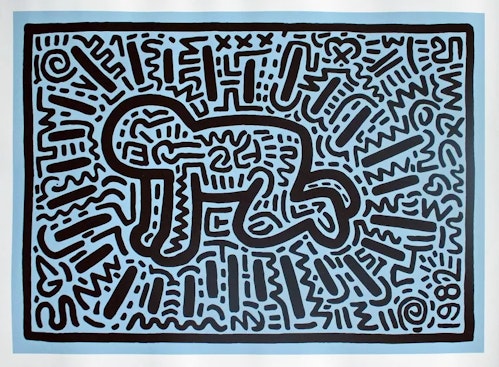
Haring was also greatly influenced by the "cut-up" technique used by novelist William Burroughs and artist Bryon Gysin, who worked in performance art and painting.
Cut-up" is an accidental literary technique in which text is randomly cut up and reassembled into new text.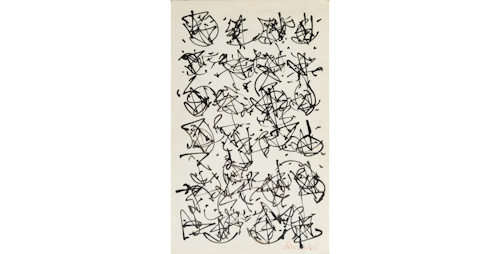
Bryon Gysin, "Magic Mashrooms," 1961.
In Haring's work, simple characters and word/letter elements are found. For example, there is a project in which short "headlines" are affixed to lamp posts throughout Manhattan. These used phrases such as "Reagan Assassinated by Hero Cop" and "Pope Killed for Freed Hostages," and the random and sensational phrases that emerged from the cut-ups were controversial.
Haring continued to organize exhibitions with friends, and in 1982, he created a large-scale mural on the walls of the Lower East Side. The medium of mural painting continued to occupy an important place in Haring's artistic expression.
At this time, Haring was working at an astonishing pace, sometimes completing as many as 40 paintings in a single day.
The most significant element that characterizes Haring's work is the keyword "homosexuality. This is expressed in "Untitled" (1982), which depicts two figures with radiant hearts and love motifs, demonstrating his originality as early as this painting.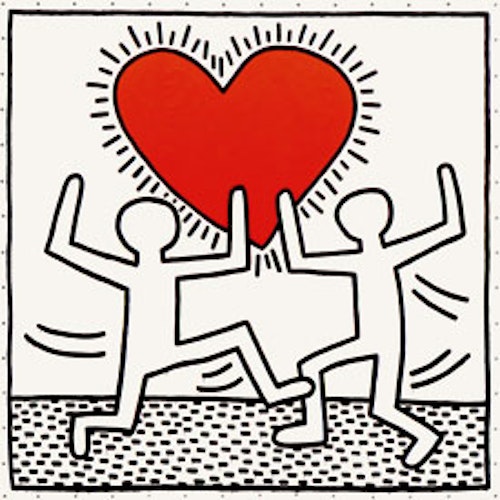
Untitled, 1982
In 1982, Haring participated in documenta 7 in Kassel, where his work was exhibited alongside world-class artists such as Beuys, Kiefer, Richter, Twombly, and Warhol.
Basquiat, who was just 21 years old, also participated in documenta, making Haring and Basquiat, both American participants, very iconic street artists in their early 20s.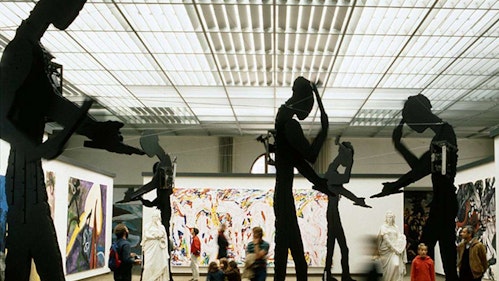
They continued to make a significant presence in the art world, participating in the Sao Paulo Biennial and the Whitney Biennial in 1983.
He also collaborated with Vivienne Westwood, and the singer Madonna wore his work in a music video, which truly catapulted him to stardom.
While the price of Haring's work skyrocketed, he continued to graffiti on the subway, and he also distributed free buttons and posters.
In 1986, Haring opened a pop-up store in Soho, New York. The shop sold printed shirts, posters, and other items from Haring's work, fulfilling his greatest desire to "bring his work to the public. From his earliest days, Haring was uncomfortable with the idea of his work being confined to museums and seen only by a few people, and he believed that Pop Art should be available to the masses. With the same motivation, he actively created murals in museums and various institutions around the world..jpg?w=500&h=665)
Hering working on a mural at the Amsterdam Municipal Museum of Art in 1986
Hering was sometimes criticized for commercializing art in the act of opening a store, but he commented on this as follows.
I could make a lot more money if I painted a few pieces and drove up the price. My store is an extension of what I did in the subway station, breaking down the barrier between high art and the art of the common man."
Also, since the appearance of Pop Shops, the recurring messages in his work have been marked by more socio-political themes, such as anti-apartheid, AIDS awareness, and opposition to crack cocaine.
Herring disclosed his gay sexuality to the public. Because very few people were open about their sexuality at the time, he was providing support for sexual minorities through his work. Safe sex, AIDS awareness, etc. were claimed for that reason.
However, in 1988, Haring herself was diagnosed with AIDS.
Moreover, with the death of Warhol the previous year, in 1987, and Basquiat at almost the same time, in late 1988, Haring may have felt that he had been left behind.
In the last few years of his life, he developed various activities to spread awareness about AIDS.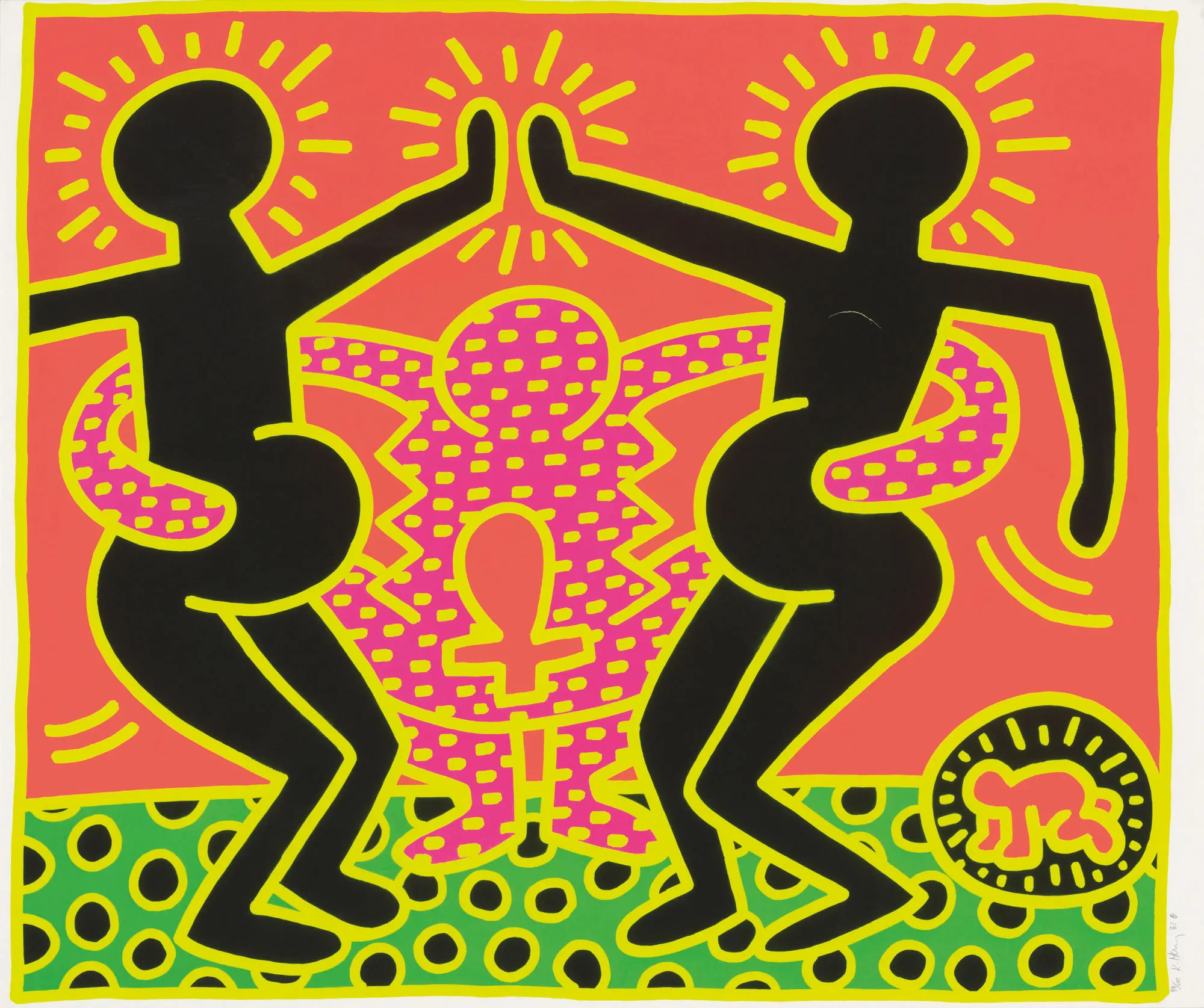
Fertility Suite Untitled no.4, 1986
In 1989, with the work "Rebel with Many Causes," he criticized the system that avoids social issues such as AIDS, and critically addressed the "see no evil, speak no evil, hear no evil" issue in his work.
Haring also participated in a mural project created to commemorate AIDS Awareness Day on December 1 of the same year, and told the Los Angeles Times, "My life is my art.
My life is my art. Life and art are intertwined.
AIDS became a reality in my life and the subject of my paintings.
The greater the impact of the disease on my life, the more it transformed my work."
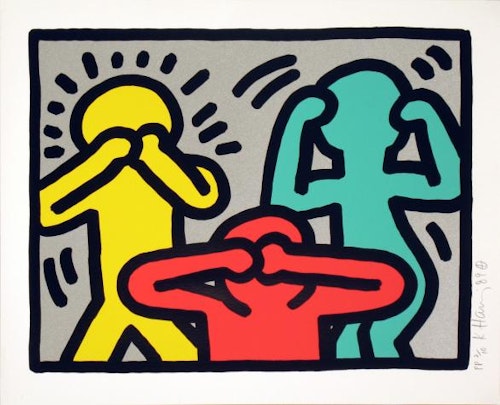
Haring's distinctive art can still be seen frequently in various fashion collections, and his collaborations with various apparel brands, including Adidas, Lacoste, UNIQLO, Supreme, Reebok, and Coach, are always popular with young people.
Collaboration with HM
Haring's signature motif "Radiant Baby" depicts a baby with lines radiating out, which is actually thought to allude to Christ's childhood.
He continued to create images depicting the Christ child even during his career as a subway artist. Some of these were nativity scenes painted in his distinctive style.
If we look at Haring's works with attention to the religious aspect of his work, we may discover a foundational idea that is more than just pop and cute.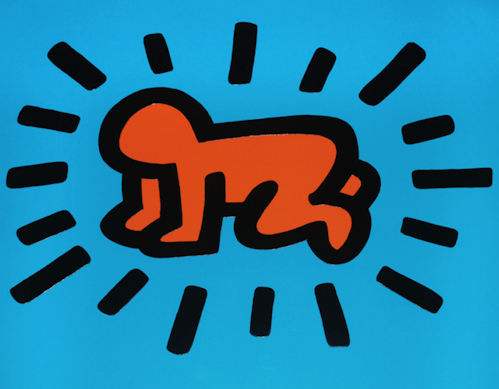
In Japan, the Nakamura Keith Haring Museum, which houses many of Haring's works, is located in Yatsugatake, Yamanashi Prefecture.
Opened in 2007 by Kazuo Nakamura and designed by contemporary architect On Kitagawara, the museum is a space where visitors can confront the "madness hidden in human beings" and "life and death" that lie deep within Haring's works.
The museum introduces Haring's works and life from various angles, and holds special exhibitions throughout the year that feature collaborations between Haring and contemporary artists.
Official Site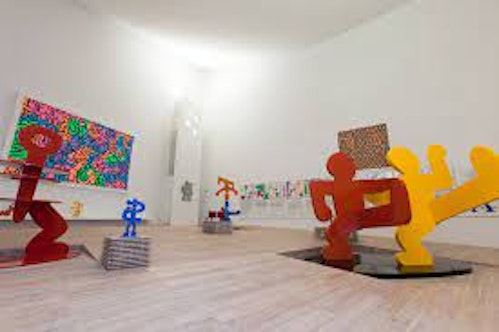

Writer
TRiCERA ART
Pop and cute stick figures (?) in various poses. Stick figures in various poses.
The art created by Keith Haring (1958 - 1990) is loved around the world.
In this issue, we will introduce the life and works of Keith Haring, who is known as a pioneer of street art in the United States.

Keith Haring is a representative of the graffiti culture that swept New York City in the 1980s, known for his instantly recognizable drawings of people and dogs with a simple touch.
His career began with graffiti on the New York subway, which quickly became popular with the public, and he went on to create murals and other works in public spaces that are often referred to as public art.
In Japan, the Nakamura Keith Haring Museum of Art was established in 2007 in Yatsugatake, Yamanashi Prefecture, and continues to play a role in introducing Haring to Japanese art fans with its contemporary architecture and colorful, fun museum store.
His sexuality is an important feature of Haring's work.
Many of his works also allude to his sexuality. He has continued to look at the nature of his own homosexual orientation in his work, and he is also highly regarded as an activist who has been openly advocating for sexual minorities since the early days when gender activism was not a common practice.
Haring was born in Pennsylvania into a devout Christian family.
He was interested in drawing from an early age and painted with his father.
It is also said that she often watched cartoons such as Walt Disney's animated cartoons, Dr. Seuss, Charles Schulz, and The Bugs Bunny Show, which are thought to have been the basis for her later pop style.
After high school, he studied at the Ivy School of Professional Art in Pittsburgh, but became bored with the coursework and began to search for his own unique pursuits.
He was so struck by Robert Henri's "The Spirit of Art" (1923) that he began to create what he wanted to create, as if absorbed in the process.
Around 1978, when he was around 20 years old, Haring was working at the Pittsburgh Center for the Arts, where he was greatly influenced by the great artists whose works he saw up close.
He was struck by the power of works by Pierre Alessinsky, Jean Dubuffet, Jackson Pollock, Mark Tobey, and others. He also heard a lecture by Christo, a native of France who worked on various large-scale projects as Christo & Jeanne-Claude, a husband and wife team, which shaped his fundamental ideas about the value of art in the public sphere.
Pierre Alesinski, "Dotremont dans sa nuit lapone

Around the same time, Haring began studying painting at the School of Visual Arts (SVA) in New York City.
He also worked part-time in nightclubs and explored new forms of expression such as video and performance art.
While still in school, he created graffiti art on the Manhattan subway, which attracted a lot of attention.
Haring first began painting with white chalk on the backs of unused advertising boards. The "Radiant Baby" series, a motif that has come to symbolize Haring, was being painted as early as this time.
Haring was also greatly influenced by the "cut-up" technique used by novelist William Burroughs and artist Bryon Gysin, who worked in performance art and painting.
Cut-up" is an accidental literary technique in which text is randomly cut up and reassembled into new text.
Bryon Gysin, "Magic Mashrooms," 1961.
In Haring's work, simple characters and word/letter elements are found. For example, there is a project in which short "headlines" are affixed to lamp posts throughout Manhattan. These used phrases such as "Reagan Assassinated by Hero Cop" and "Pope Killed for Freed Hostages," and the random and sensational phrases that emerged from the cut-ups were controversial.
Haring continued to organize exhibitions with friends, and in 1982, he created a large-scale mural on the walls of the Lower East Side. The medium of mural painting continued to occupy an important place in Haring's artistic expression.
At this time, Haring was working at an astonishing pace, sometimes completing as many as 40 paintings in a single day.
The most significant element that characterizes Haring's work is the keyword "homosexuality. This is expressed in "Untitled" (1982), which depicts two figures with radiant hearts and love motifs, demonstrating his originality as early as this painting.
Untitled, 1982
In 1982, Haring participated in documenta 7 in Kassel, where his work was exhibited alongside world-class artists such as Beuys, Kiefer, Richter, Twombly, and Warhol.
Basquiat, who was just 21 years old, also participated in documenta, making Haring and Basquiat, both American participants, very iconic street artists in their early 20s.
They continued to make a significant presence in the art world, participating in the Sao Paulo Biennial and the Whitney Biennial in 1983.
He also collaborated with Vivienne Westwood, and the singer Madonna wore his work in a music video, which truly catapulted him to stardom.
While the price of Haring's work skyrocketed, he continued to graffiti on the subway, and he also distributed free buttons and posters.
In 1986, Haring opened a pop-up store in Soho, New York. The shop sold printed shirts, posters, and other items from Haring's work, fulfilling his greatest desire to "bring his work to the public. From his earliest days, Haring was uncomfortable with the idea of his work being confined to museums and seen only by a few people, and he believed that Pop Art should be available to the masses. With the same motivation, he actively created murals in museums and various institutions around the world..jpg?w=500&h=665)
Hering working on a mural at the Amsterdam Municipal Museum of Art in 1986
Hering was sometimes criticized for commercializing art in the act of opening a store, but he commented on this as follows.
I could make a lot more money if I painted a few pieces and drove up the price. My store is an extension of what I did in the subway station, breaking down the barrier between high art and the art of the common man."
Also, since the appearance of Pop Shops, the recurring messages in his work have been marked by more socio-political themes, such as anti-apartheid, AIDS awareness, and opposition to crack cocaine.
Herring disclosed his gay sexuality to the public. Because very few people were open about their sexuality at the time, he was providing support for sexual minorities through his work. Safe sex, AIDS awareness, etc. were claimed for that reason.
However, in 1988, Haring herself was diagnosed with AIDS.
Moreover, with the death of Warhol the previous year, in 1987, and Basquiat at almost the same time, in late 1988, Haring may have felt that he had been left behind.
In the last few years of his life, he developed various activities to spread awareness about AIDS.
Fertility Suite Untitled no.4, 1986
In 1989, with the work "Rebel with Many Causes," he criticized the system that avoids social issues such as AIDS, and critically addressed the "see no evil, speak no evil, hear no evil" issue in his work.
Haring also participated in a mural project created to commemorate AIDS Awareness Day on December 1 of the same year, and told the Los Angeles Times, "My life is my art.
My life is my art. Life and art are intertwined.
AIDS became a reality in my life and the subject of my paintings.
The greater the impact of the disease on my life, the more it transformed my work."

Haring's distinctive art can still be seen frequently in various fashion collections, and his collaborations with various apparel brands, including Adidas, Lacoste, UNIQLO, Supreme, Reebok, and Coach, are always popular with young people.
Collaboration with HM
Haring's signature motif "Radiant Baby" depicts a baby with lines radiating out, which is actually thought to allude to Christ's childhood.
He continued to create images depicting the Christ child even during his career as a subway artist. Some of these were nativity scenes painted in his distinctive style.
If we look at Haring's works with attention to the religious aspect of his work, we may discover a foundational idea that is more than just pop and cute.
In Japan, the Nakamura Keith Haring Museum, which houses many of Haring's works, is located in Yatsugatake, Yamanashi Prefecture.
Opened in 2007 by Kazuo Nakamura and designed by contemporary architect On Kitagawara, the museum is a space where visitors can confront the "madness hidden in human beings" and "life and death" that lie deep within Haring's works.
The museum introduces Haring's works and life from various angles, and holds special exhibitions throughout the year that feature collaborations between Haring and contemporary artists.
Official Site

Writer
TRiCERA ART